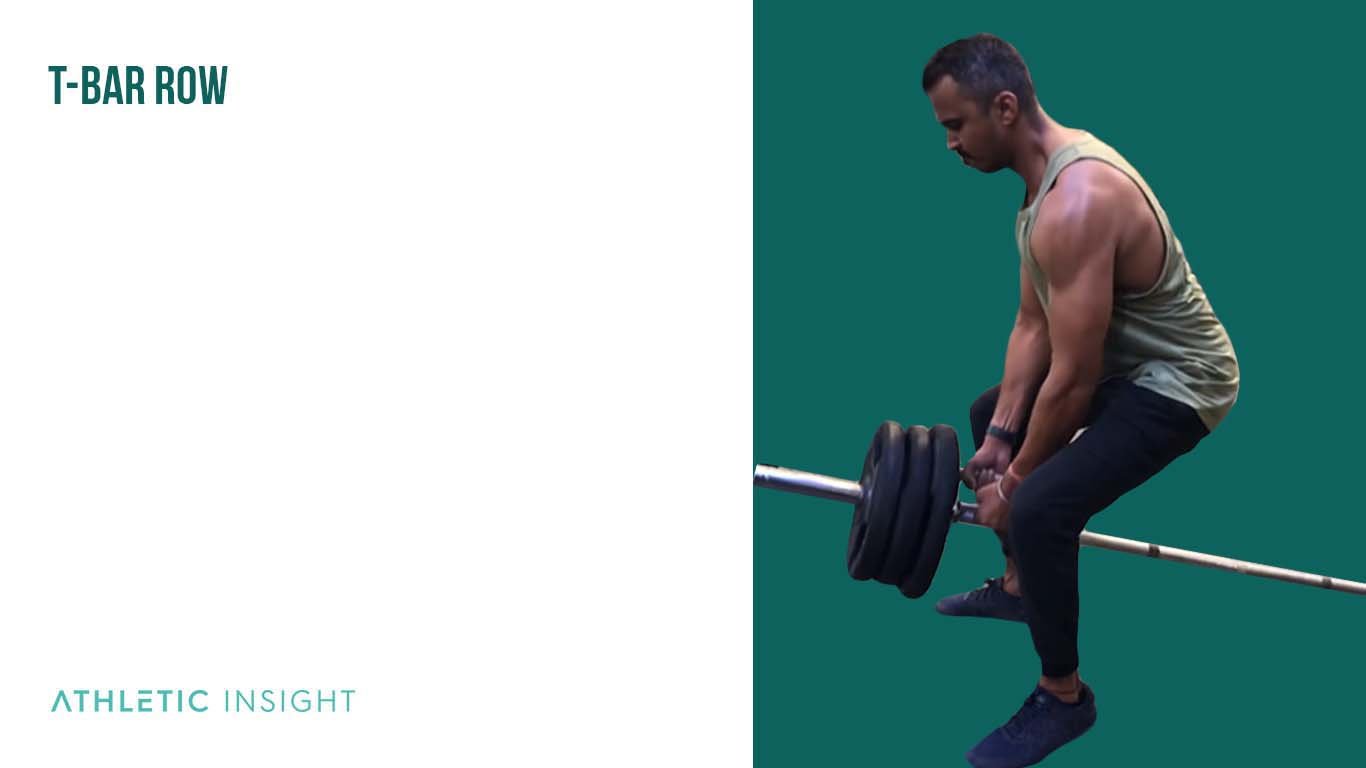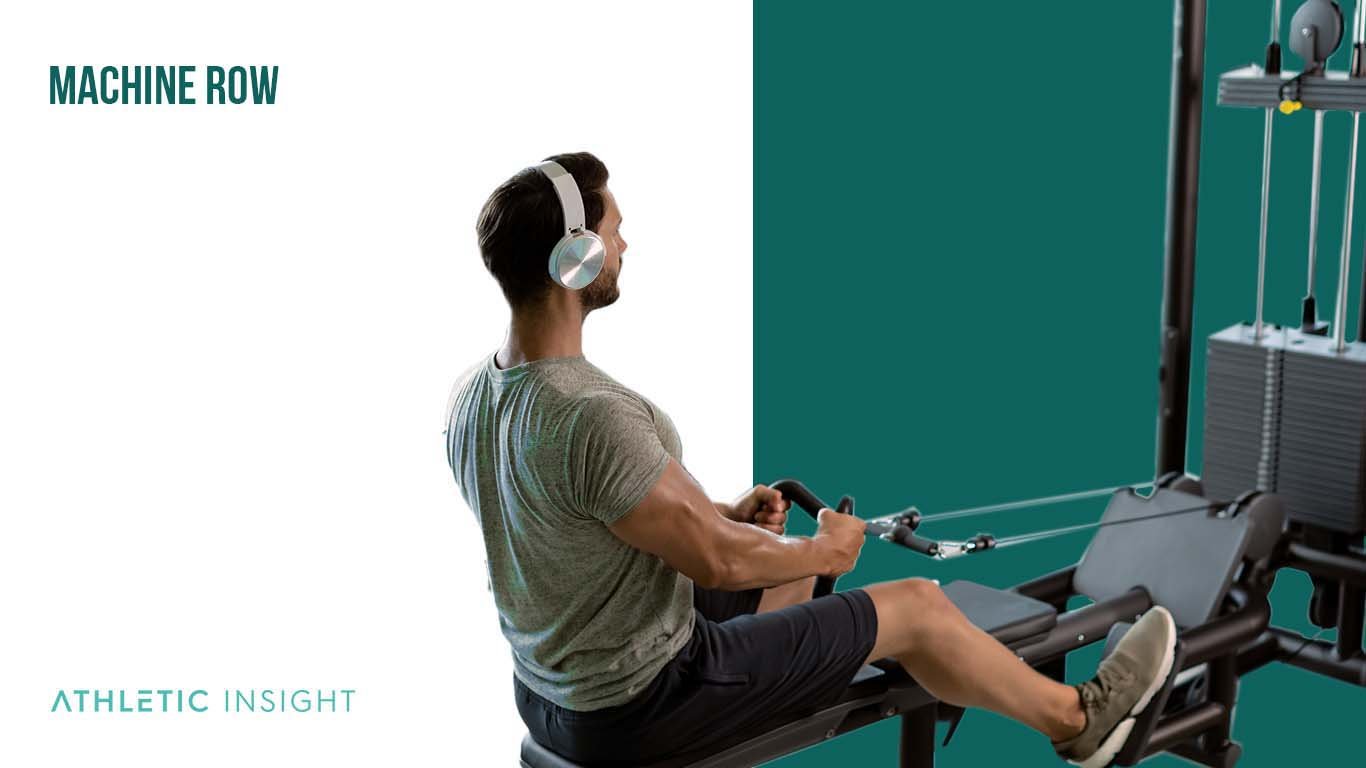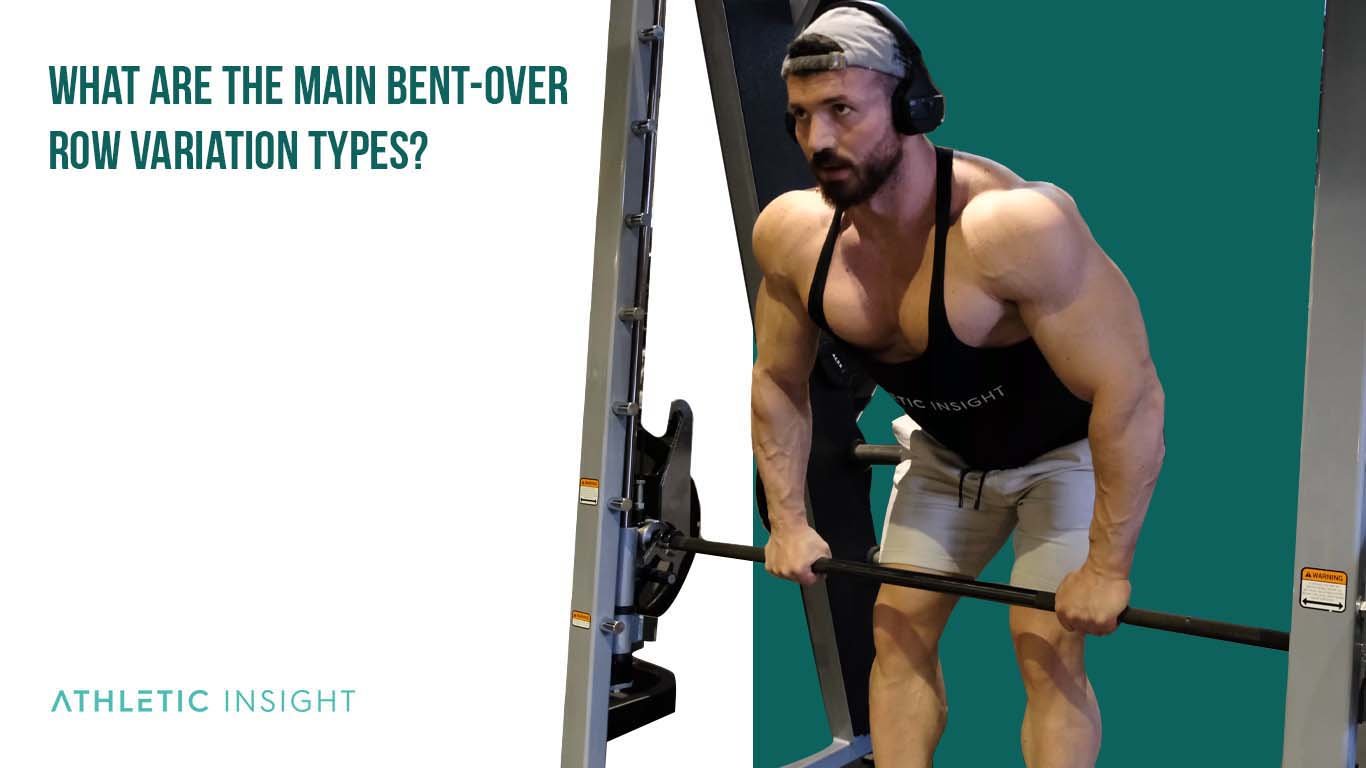If you want to enhance your muscle tone, size, and shape, the barbell bent-over row is a popular compound exercise practiced in gyms around the world. Your lumbar spine will particularly feel the burn, but the weight load evenly distributes along your back for balance, providing an effective back workout for beginners and experts alike.
All barbell bent-over row (sometimes shortened to bb rows) modifications build muscle and tone everything from your lats to your biceps. Some variations lean towards controversial (such as the Pendlay), but other versions like the trap bar bent-over row are more approachable.
Novice lifters can work on their muscle definition with several beginner-level variations (like the Inverted and kettlebell bent-over row variation) that are no less strenuous. Barbell bent-over weight variations also exist, so if you want to change up your routine or focus on a specific area, you can adjust your method to do just that.
That said, if you want to buff up your back, the best variation is the classic barbell bent-over row. Your back, lats, arms, and butt will firm up, plus this method helps your deadlift. The other variations concentrate more on triceps, biceps, and core training. Read on for more about barbell row variations and how they benefit your body.
1. Dumbbell Row
The dumbbell row is a bent-over row variation that focuses on the lat muscles (latissimus dorsi) and benefits athletes working on both their arms and back.
All you need is a bench and a dumbbell. Place one leg on the bench and leave the other grounded. Next, use your arm on the same side of the grounded leg, bend your arm until the dumbbell touches your inner bicep, then release.
Dumbbell rows work each side of your body one at a time, so your core is doing double the work. Most people perform dumbbell rows to grow their back muscles, but it is also an effective exercise for burning calories and improving definition.
This is an excellent exercise for both male and female weightlifters of any age. This dumbbell lift is the perfect choice if you want to work on several muscles such as the teres major, trapezius, and rhomboids
One mistake lifters make is not engaging their core during exercise. While the dumbbell row concentrates on your arms and upper back, you still need to involve the abdomen to reap the fat-burning benefits. The easiest way to identify if you do this is if your lower back arches.
When you perform a dumbbell row, ensure you pull your belly button into your spine to prevent arching and promote muscle gain. Keep your neck aligned with your spine. Not doing so may increase your chances of a back injury.
2. Pendlay Row
The Pendlay Row is a barbell bent-over row variation that targets the lats and bicep muscles for powerlifters or strongmen. In addition to your lats and biceps, your hamstrings, glutes, and rear deltoids also get a workout. The Pendlay Row works best for those looking to increase their muscle mass everywhere and not just in a specific area.
To complete a Pendlay Row, you must follow the steps and maintain good form. Proper form includes the following steps.
- Place the barbell on the ground in front of you.
- Bend at the waist, stopping when your back is parallel to the floor.
- Grab the barbell with an overhand grip about a shoulder’s width apart.
- Engage your core, lift the barbell by squeezing your scapulae, and return it to the floor.
Both men and women can perform a Pendlay Row, but only seasoned athletes should attempt this exercise. As one of the more controversial moves, the Pendlay Row is relatively high-risk, and the inexperienced athlete will likely not be able to handle it.
When performing a Pendlay Row, always keep your back parallel to the ground. Arching your back can cause excessive strain and lead to injury. A common mistake during a Pendlay Row is to add too much weight to your barbell – you want the weight to be less than what you may use during a traditional row. Only your arms and upper back should move during the exercise.
3. Seated Cable Row
The seated cable row is a beginner-level bent-over row variation that targets the lats and rhomboids. Variations on the seated cable row include adding/removing weights and using one arm for an added challenge.
To perform this exercise, you need a cable machine. Sit on the bench, grasp the triangle or bar overhead (ensure you do not arch your back – your biceps may be slightly bent), engage your core, and pull. The seated cable row gives you a great workout without being insanely complex – even in its proper form.
Seated cable rows can also target your upper back if you squeeze your shoulder blades as you pull. However, your torso should remain still, and your back should be straight.
If you have a history of back or shoulder injuries, you may want to try another bent-over row variation to prevent further issues. One of the common mishaps during a seated cable row is a rounded back, which causes shoulder strain. For proper form, ensure you return the triangle or bar slowly to minimize impact.
4. Helms Row
Intended for athletes and weightlifters looking for a challenge, the Helms Row is one of the most controversial bent-over rows on this list. A Helms row is an isolated exercise that concentrates on your rhomboids. Your rhomboids surround your upper spine, making it a superior workout for your shoulders.
To do a Helms row, use weights that are not too heavy but still challenging. Pick up the dumbbells and lean forward, resting your chest on the bench. Keep your feet at the hips width and slightly behind your body. Pick up the dumbbells and bend your arms at a 90-degree angle.
Men and women can perform Helms rows, but only those experienced in weightlifting. Newbies should never attempt this exercise as it is dangerous if performed incorrectly. A popular variation of the Helms row is the chest-supported barbell lift, which focuses on the shoulders but does not involve dumbbells.
The improper form may crush your sternum or cause severe injuries to your abdominals. The most common mistake during a Helms row is engaging the mid and lower back muscles excessively, causing weak form and defeating the purpose of the exercise.
Before you take your chances with a Helms row, lay a towel on the bench to pad your sternum. Keep your knees slightly bent to minimize pressure.
5. Yates Row (Underhand Bent-Over Row)
The Yates row targets the lats (latissimus dorsi), rhomboids, posterior deltoids, and biceps (biceps brachii). It is a supinated barbell row or an underhand barbell row.
To perform a Yates row, keep your form in mind to prevent injury. To perform the yates row, follow these steps.
- Use an underhanded grip.
- Pull your shoulders down and back and engage your core. Bend your knees slightly.
- Place your feet about a hip-width apart. Using only your torso and keeping your back straight, bend at the waist.
- Pull the barbell to your sternum. Squeeze your shoulders and release.
The Yates row is related to the Pendlay row but is different in that it does not involve the lower back as much. Instead, the lats and upper back are the stars of the show. Avoid the common mistake of arching your back – otherwise, you might end up with a painful pulled muscle.
This row weightlifting method is medium-level, so less risky than a Pendlay or Helms, but still not the easiest. Male and female intermediate weightlifters or powerlifters will get the most benefit from this exercise.
When doing a Yates row, pull with your elbows and not your biceps. You should also keep your entire body still, aside from your arms.
6. T-Bar Row
A T-Bar row is a bent-over row variation that tests your latissimus dorsi strength by applying significant weight to your barbells. Athletes of any skill level can do a T-Bar row as long as they adjust the barbell weights accordingly.

The T-Bar Row is a classic bent-over row beloved for its endurance-building movements that give serious back gains. Everything from your lats to your hamstrings gets a workout with a T-Bar row, and the more often you do it, the heavier you can go.
If you are a beginner, the variation of a T-Bar row you should try is the lying-down method – you rest your sternum on a padded bench and perform the lift from there. However, a proper T-Bar row requires you to keep a neutral spine, bent knees, and no resting pad.
To execute a proper T-Bar row, load the T-Bar with your desired weight and step onto the platform. Shift your hips back and keep your torso parallel to the floor. Grasp the weight handles and pull towards your chest while squeezing your glutes and shoulders. Fully extend your arms. Tuck your navel into your spine and take deep breaths.
Newbies should not do a traditional T-Bar row until they understand their weight limits. Possible injuries from the poor form are sciatica, lumbar pain, and herniated discs. Beginners should use the laying-down variation to prevent spinal flexion.
7. Barbell Corner Row (Barbell T-Bar Row)
The barbell corner row targets the lats (latissimus dorsi) and deltoids. All skill levels and genders can benefit from corner rows, but the exercise is not without ailments. Injuries due to improper form like torn muscles and shoulder strain often occur during barbell back rows.
Setup is essential for a proper barbell corner row. Place a long barbell on the ground, with one side weighed down. The catch is that you must put one end of the barbell in a corner. Straddling the barbell, pick it up by the weighted end and bring it to your chest. Hook a close-grip handle to the bottom of the weight.
The closest variation is the traditional T-Bar row, but the corner row may be more appealing to those who work out at home. Just remember to keep your back straight and never use more weight than you can handle, both of which are common mishaps during corner rows. As with most barbell rows, keep your feet a hip-width apart and shoulders squared as you push and pull your legs.
8. Barbell Seal Row
Controversial but effective, the Barbell Seal row works the biceps brachii and thickens back muscles like no other. Only expert powerlifters should perform this bent-over row variation (although male and female lifters can do it).
Unlike the different types of barbell rows, the seal row requires you to extend your arms all the way – so you will need a bench high enough to accommodate that if your arms are longer than most. To execute the perfect Barbell Seal row, start with the following steps and keep practicing.
- Lay face-down on the bench with the barbell beneath you. Your knees and feet should rest on the foot supports of the seat.
- Grab the barbell with an overhand grip, keeping your hands slightly wider than shoulder-width apart.
- Pull the barbell up as far as you can. The goal is to touch the bottom of the bench.
- Slowly lower the barbell to the floor.
Seal row variations depend on how spread your hands are on the barbell. A narrow grip targets the lats, while a wide grip will pound your upper and middle back muscles.
A common mistake during a seal row is to lift the chest upwards while moving the barbell. Not only does this disrupt the intention of the exercise, but it also leads to potential neck injuries and will not grow your muscles.
The main aspects of this exercise to remember are to control your barbell and keep your elbows stationary.
9. Chest-Supported Row
The chest-supported bent-over row variation targets the lats and biceps. This barbell row alternative is an excellent option for beginners or athletes with little to no muscle mass, as it is straightforward but still a challenge.
The chest-supported row makes a great T-Bar rows alternative. All you need to do is set a bench at a 45-degree angle. Using a pair of dumbbells, lay face-down on the bench and keep your feet grounded. Squeeze your shoulders and lift your elbows.
When doing a chest-supported row, the biggest mistake you can make is completing the exercise too quickly. Not only does this decrease its effect, but it also puts more strain on your body and may result in pulled muscles or rotator cuff injury.
To keep proper form, always keep your chest on the bench. Never lift your abdominals during a chest-supported row, as it defeats the purpose. Choose a lighter weight if you feel the urge to get up. If you want to do a variation of this row, try laying down (flat bench row).
10. Machine Row
The machine row is an easy exercise for male and female athletes new to weight lifting. This bent-over row variation provides support and reduces the risk of injury. Try a machine row if you want to grow your lats, upper back, and biceps brachii.

Start by adding your desired weight to the machine. Then, sit in the provided seat and rest your chest on the pad. Use a neutral grip and grab the handles, keeping your chest against the cushion. Pull the handles towards you as far as possible, keeping your scapulae engaged. Lower the weight, but do not drop it.
A simple mistake when doing a machine row is to move the eyes and head around while lifting. Keep your head forward and your eyes fixed to prevent distractions or injury.
11. Inverted Row
The inverted row is an excellent exercise for male and female athletes looking to increase back muscle. This exercise targets the trapezius, rhomboids, latissimus dorsi, and core. Another plus of the inverted row is it works for all skill levels.
Inverted row variations include inverted row slides, alternate grip inverted rows, and ultra-wide grip inverted rows. The traditional inverted row is the least challenging. For a perfect inverted row, ensure you maintain your form.
- Set the bar at waist height.
- Get under the bar and grasp it with your palms facing out.
- Engage your core and glutes, keeping your body straight.
- Pull yourself up to the bar and back to the ground.
If you need something a bit easier, try lifting the bar high enough that you can stand underneath it. Then repeat the same movements in an upright position.
Despite how easy an inverted row seems, you can still make mistakes or hurt yourself if you do it incorrectly. Remember to keep your hands a shoulder-width apart to prevent the weight from becoming unstable.
12. Barbell Dead Row
The barbell dead row is a bent-over row variation for mid-level male and female powerlifters. Considered a variation of the Pendlay Row, this exercise is less demanding but works similar muscles – the latissimus dorsi, trapezius, shoulder blades, and glutes all get a decent workout.
The barbell dead row has several unique characteristics. For one, you do not return the barbell to the ground after a rep. For proper form, keep the barbell close to your chest and knees. The middle of your foot should mark the middle of the bar, and while having a neutral spine, pull the bar to your knees and lower abdomen.
Barbell dead rows are notorious for causing slipped discs. Avoid this common mistake by maintaining a neutral spine. Do not let your hips do all of the work – ensure your upper back feels the burn.
13. Sliding Bent-Over Row
The sliding bent-over row targets the upper back and lats (latissimus dorsi). This row variation works for all skill levels and genders. This is a one-sided barbell row.
Begin by getting on all fours, and placing one hand on each dumbbell. Staying in the plank position, lift one dumbbell at a time using your elbows. Place the dumbbell back on the floor and do the same thing on the opposite arm.
A common mistake to avoid is letting your back sag. While the sliding bent-over row may not be the most dangerous or controversial on this list, you can still cause shoulder damage or lower back pain if you take shortcuts. Take deep, steady breaths and concentrate on your elbow motion for proper form.
The dumbbell renegade row and incline bench dumbbell row are variations of this exercise.
What Are the Main Bent-Over Row Variation Types?
Bent-over barbell rows fall into several categories – controversial, beginner, and classic are the main types. All types require proper barbell rows form. Classic rows include the traditional dumbbell row, T-Bar row, and inverted row. The controversial rows are Pendlay, Helms, and Yates. Beginner rows are the chest-supported row, machine row, and inverted row.

All powerlifters and athletes should incorporate classic bent-over rows into their regimens, while expert weightlifters should be the only athletes completing the controversial lifts. Beginners should only perform rows if they know how much weight they can handle.
What Are the Bent-Over Row Variations for Biceps?
The Bent-Over is an effective exercise and one of the best biceps workouts to include in a routine. Several bent-over row variations target the biceps as well as the back beyond the back rows barbell. Most of these work for beginner levels and weightlifting experts.
- Seated cable row
- Chest-supported row
- Barbell seal row
What Are the Bent-Over Row Variations for Lats?
There are many Bent-Over Row variations that target the lats. These include the Helms Row, Pendlay Row and T-Bar Row. As these are intense workouts, powerlifters may find them the most beneficial.
- Helms row
- Pendlay row
- T-bar row
If done correctly, the Bent-Over Row is an effective workout to include in your back exercise routine but having variations will further develop the back.
What Are the Beginner Level Bent-Over Row Variations?
Some bent-over row variations may not work for new lifters. Beginner-level rows include the following. These work for beginners because they allow a stabilized torso and do not require excessive strength.
- Machine row
- Seated cable row
- Inverted Row
What Are the Controversial Bent-Over Row Variations?
Beginners should never attempt a controversial row. These include the following and may increase your risk of injury. They are controversial because the risk of injury is substantial, crushed sternums and severe back injuries are possible if not executed properly.
- Helms Row
- Yates Row
- Pendlay Row
Which Bent-Over Row Variation Is Easier to Perform?
The most accessible variation to perform is the machine row. The machine gives the athlete additional guidance and does not require stabilizing muscles. Look at How to do Bent-Over Row.
Which Bent-Over Row Variation Is the Hardest to Perform?
The most difficult bent-over row is the Helms row. Getting in the proper position is difficult, even without holding the dumbbells.
Which Bent-Over Row Variation Can Be Included in the PPL Routine?
The PPL is short for push, pull, and legs. This method trains all the muscle groups and allows your body to recover between workouts. All of the above bent-over row variations will work in a PPL routine.
What Are the Bent-over Row Alternatives?
Some alternatives to bent-over rows are reverse grip row with a barbell, lying bench rows, and TRX row. The difference between a variation and an alternate is that a variation is a minor change to an exercise and an alternative normally adds another dimension to the exercise (or takes something away).
A reverse grip row with a barbell differs from a bent-over row because you perform it with your hands facing up instead of down. Lying bench rows and TRX rows are alternatives because they involve different actions than a traditional bent-over row (i.e., lying down).



